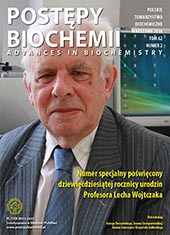Carnitine â mitochondria and beyond
Abstract
Carnitine [(3R)-3-hydroxy-4-(trimethylazaniumyl)butanoate] in mammals is mainly delivered with diet. It enters the cell due to the activity of organic cation/carnitine transporter OCTN2 (SLC22A5), it can be as well transported by CT2 (SLC22A16) and a transporter of neutral and basic amino acids ATB0,+ (SLC6A14). The hydroxyl group of carnitine is able to form esters with organic acids (xenobiotics, fatty acids) due to the activity of acylcarnitine transferases. Carnitine is necessary for transfer of fatty acids to mitochondria: in functioning of the so-called carnitine shuttle an essential role is fulfilled by palmitoylcarnitine transferase 1, carnitine carrier (SLC25A20) in the inner mitochondrial membrane and palmitoylcarnitine transferase 2. Oxidation of fatty acids takes also place in peroxisomes. The produced medium-chain acyl derivatives are exported as acylcarnitines, most probably by OCTN3 (Slc22a21). It has been postulated that acylcarnitines can cross the outer mitochondrial membrane through the voltage-dependent anion channel (VDAC) and/or through the palmitoycarnitine transferase 1 oligomer. Mutations of genes coding carnitine plasma membrane transporters result in the primary carnitine deficiency, with symptoms affecting normal functioning of muscles (including heart) and brain. Mechanisms regulating functioning of these transporters have been presented with emphasis on their role as potential therapeutic targets.
Downloads
Published
Issue
Section
License
All journal contents are distributed under the Creative Commons Attribution-ShareAlike 4.0 International (CC BY-SA 4.0) license. Everybody may use the content following terms: Attribution — You must give appropriate credit, provide a link to the license, and indicate if changes were made, ShareAlike — If you remix, transform, or build upon the material, you must distribute your contributions under the same license as the original. There are no additional restrictions — You may not apply legal terms or technological measures that legally restrict others from doing anything the license permits.
Copyright for all published papers © stays with the authors.
Copyright for the journal: © Polish Biochemical Society.




